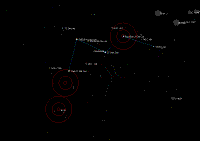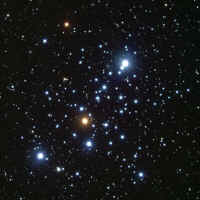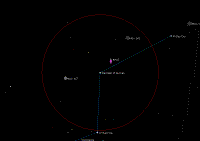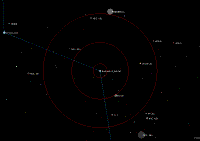M103 (open cluster in Cassiopeia)
160: M52 and M103 Overview
The second open cluster in Cassiopeia is M103. M103 is dimmer, looser, and generally even less impressive than M52. Hereís what it looks like photographed in a large scope.
170: M103
Messierís friend and collaborator Pierre Mechain discovered M103 in March or April of 1781, and Messier added it to his list as a handwritten annotation before observing it himself. The primary significance of M103 is that it was the last object officially added to Messierís catalog.
M103 has about 40 member stars, and at 8,000 to 9,500 light years is one of the most distant of the open clusters in Messierís catalog. The most obvious feature of M103 is the binary star Struve 131, with components at 7.3 and 10.5 magnitude, separated by about 14 arcseconds. Ironically, Struve 131 is not actually a member of this cluster. The two brightest stars that are actually cluster members are about 10.5 magnitude, and there is a prominent red giant of magnitude 10.8. M103 is variously estimated from 9 million to 25 million years old.
The Astronomical League rates M103 as an ďEasyĒ object with 7X50 binoculars, in which it is visible as a nebulous fan-shaped patch. On a clear night at Bullington, M52 is easy enough with binoculars, but thereís so little there you might not realize you have it. M103 is even more difficult to identify in a scope because itís so sparse that itís easily confused with other stars and clusters in the field of view. The first time you get M103 in your scope, you probably wonít realize that thereís actually an object in your field of view. It looks pretty much just like background stars. The full extent of M103 is about a 6 arcminute circle, or about a fifth the diameter of the full moon
180: M103 with binoculars
To find M103 in binoculars, center them on Ruchbah, which is the bottom left star of the ďWĒ in Cassiopeia. M103 will be visible as a hazy patch about 1/3 of a field toward 45 Epsilon Cassiopeia, which is the top left star. Donít confuse M103 with NGC 663, which is a brighter nebulosity located near the edge of your field.
190: M103 with Telrad (overview)
To get M103 into your eyepiece, put Ruchbah in the center of your Telrad, where M103 will be invisible, but located on the 2-degree circle.
200: M103 with Telrad (detail)
Pivot the scope about half a Telrad field toward 45 Epsilon Cassiopeia and slightly off that line in the direction indicated. Use your lowest-power eyepiece, in which M103 will be centered.




